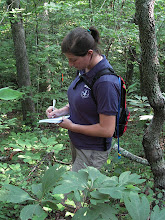I'm sitting here in Fayetteville, watching the sun set over northwest Arkansas. The scene that spreads below me is one of rapid urban sprawl, clawing and stomping its way through the valleys and highland plains. Just east of this scene, however, lies county upon county of sparsely populated, mountainous terrain where old homesteads lie a-mouldering in forgotten hollers. Williams Woods is one such lonely place. The
Williams House, built of hand-hewn logs by two brothers in the 1930s, is draped in fallen branches from the January ice storm. The 3-mile loop trail on the property built by the Ozark Highlands Trail Association is nearly impassable. But the facade of general neglect hides a mountain with a long history and rich (bio)diversity. My job in the coming months is to gain perspectives on this chunk of earth from every possible angle. From the tree species that cling to rocky hillsides to the letters once penned on a front porch flanked by irises, lilies and jonquils, all of it is mine to explore.
Exploration is not the goal, however. John Zachary Young, a biologist, once said:
Too often in the past we have been content to accumulate unrelated facts. It is splendid to be aware of many details, but only by the synthesis of these can we obtain either adequate means for handling so many data or knowledge of the natures we are studying.
My real job, then, is to find the links, the interconnectedness. How do Yellow Wood Sorrell and a mail-order Victrola fit into the same story? What was Mack Mountain like 1000 years ago, what is it today, and what might it be in the future?
A challenge, indeed.

No comments:
Post a Comment